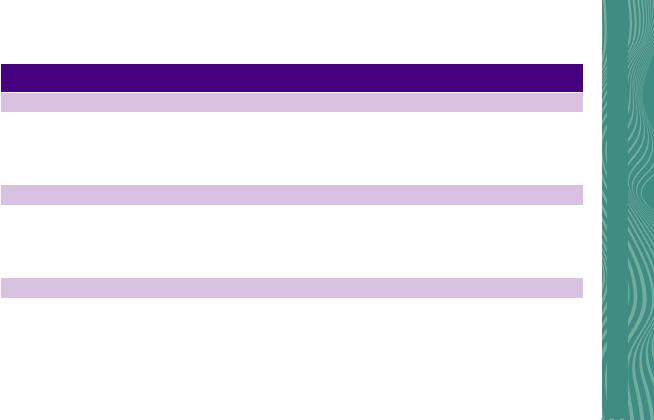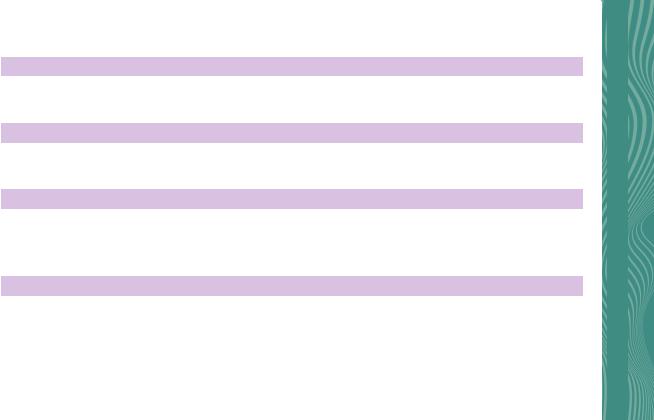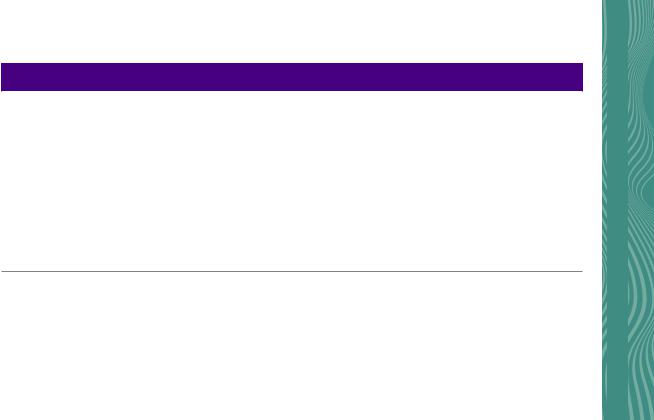
- •Contributors of Campbell-Walsh-Wein, 12th Edition
- •Patient history and physical examination
- •Clinic visit set-up
- •Patient history
- •Chief complaint (CC)
- •History of present illness (HPI)
- •Constitutional symptoms.
- •Pain.
- •Hematuria.
- •Lower urinary tract symptoms (LUTS).
- •Urinary incontinence
- •Erectile dysfunction (ED).
- •Other urologic conditions.
- •Past medical/surgical history
- •Performance status
- •Medications
- •Social history
- •Family history
- •Review of systems
- •Physical examination
- •Vital signs
- •General appearance
- •Kidneys
- •Bladder
- •Penis
- •Scrotum and contents
- •Digital rectal examination (DRE)
- •Pelvic examination in the female
- •Laboratory tests
- •Urinalysis
- •UA evaluation
- •Specific gravity and osmolality.
- •Blood/hematuria.
- •Leukocyte esterase (LE) and nitrite.
- •Bacteria.
- •Yeast.
- •Urine cytology
- •Serum studies
- •Creatinine and glomerular filtration rate (GFR)
- •Prostate-specific antigen (PSA)
- •Alpha-fetoprotein (AFP), human chorionic gonadotropin (HCG), and lactate dehydrogenase (LDH)
- •Endocrinologic studies
- •Parathyroid hormone
- •Office diagnostic procedures
- •Uroflowmetry
- •Post void residual (PVR)
- •Cystometography and urodynamic studies
- •Cystourethroscopy
- •Imaging of the urinary tract
- •Plain abdominal radiography.
- •Retrograde pyelogram (RPG).
- •Loopography.
- •Retrograde urethrography.
- •Voiding cystourethrogram (VCUG).
- •Functional imaging with nuclear scintigraphy
- •Technetium 99m –diethylenetriamine pentaacetic acid (99m TC-DTPA)
- •Technetium 99m –dimercaptosuccinic acid (99m TC-DMSA)
- •Technetium 99m -mercaptoacetyltriglycine (99m TC-MAG3)
- •Diuretic scintigraphy
- •Phamacokinetics.
- •Phases of dynamic renal imaging.
- •Urologic ultrasonography
- •Renal ultrasonography.
- •Bladder ultrasonography.
- •Scrotal ultrasonography.
- •Ultrasonography of the penis and male urethra.
- •Transperineal/translabial ultrasound.
- •Transrectal ultrasonography of the prostate (TRUS).
- •Urologic computed tomography (CT)
- •Types of CT.
- •Urolithiasis.
- •Cystic and solid renal masses.
- •Urologic magnetic resonance imaging (MRI)
- •Adrenal MRI.
- •Renal MRI.
- •Urothelial cell carcinoma (upper and lower tract).
- •Prostate MRI.
- •Nuclear medicine in urology
- •Positron emission tomography (PET).
- •Hematuria
- •Causes of microscopic hematuria
- •Selecting patients for evaluation
- •Lower tract evaluation
- •Upper tract evaluation
- •Suggested readings

2 CHAPTER 1 Evaluation of the Urologic Patient
History of Present Illness (HPI)
The HPI covers multiple factors related to the CC with the purpose of developing a differential diagnosis.
Constitutional Symptoms. These symptoms include fever, chills, night sweats, anorexia, weight loss, fatigue, and/or lethargy.
Pain. Elicit pain location, radiation, palliative factors, provocative factors, severity (1-10 scale), and timing (including onset and change over time).
•Renal pain (flank pain) – Renal pain is located at the ipsilateral costovertebral angle (CVA) lateral to the spine and inferior to the 12th rib and often radiates toward the abdomen or scrotum/ labia.
•Ureteral pain – This is often due to ureteral obstruction and may be present in the ipsilateral abdominal lower quadrant. The pain is often acute in onset and intermittent and may be referred to the scrotum/penis.
•Bladder pain – This type of pain may be due to inflammation
(cystitis) or bladder distension (urinary retention). Suprapubic in location with possible improvement after voiding.
•Prostatic pain – This is a deep pelvic pain that may be confused with rectal pain. There are often associated irritative voiding symptoms (urinary frequency, urgency, dysuria).
•Penile pain – Penile pain has a variable presentation with wide differential, including paraphimosis, penile lesions, referred pain, Peyronie’s disease, or priapism.
•Scrotal pain – This type of pain may be superficial (skin) or involve the scrotal contents. Testicular torsion is a urologic emergency.
Hematuria. Hematuria is defined as presence of blood in the urine and is divided into categories of gross (visible) versus microscopic (.3 RBC/HPF on microscopic examination) versus pseudohematuria (redness in urine of non-urologic origin). Obtain the presence or absence of associated voiding symptoms, smoking history, chemical exposure history, trauma, urinary tract infections, or recent urologic procedures. Please refer Hematuria section below for more details.
Lower Urinary Tract Symptoms (LUTS). LUTS may be obstructive or irritative in nature. Obstructive symptoms include urinary frequency, intermittency, incomplete emptying, weak stream,

CHAPTER 1 Evaluation of the Urologic Patient 3
hesitancy, and straining with voiding. Irritative symptoms include urinary frequency, urgency, dysuria, or nocturia and may be caused by chronic bladder outlet obstruction, overactive bladder, cystitis, prostatitis, bladder stones, or bladder cancer. The Interna- tional Prostate Symptom Score (IPSS) is the AUA symptom score with the addition of a quality-of-life score and is a useful tool for assessing LUTS (Table 1.1) (see Chapter 21).
Urinary Incontinence
•Stress incontinence – Involuntary passage of urine with activi- ties that increases intra-abdominal pressure including Valsalva, cough, sneeze, laugh, and/or heavy lifting.
•Urge incontinence – Involuntary passage of urine associated with sudden urge to void. This is often associated with overactive bladder, cystitis, neurogenic bladder, or poorly compliant bladder.
•Mixed incontinence – When a patient experiences both stress and urge incontinence.
•Continuous incontinence – Constant leakage of urine indepen- dent of urination patterns or intraabdominal pressure. This is often due to congenital cause or urinary fistula.
•Pseudoincontinence – Incontinence-like symptoms due to non- urologic cause such as vaginal discharge or labial fusions causing retention of urine.
•Overflow incontinence – Leakage of urine due to volume of urine exceeding bladder capacity. This is common in bladder outlet obstruction.
•Functional incontinence – Leakage of urine due to patient immo- bility or inadequate access to facilities. Patients otherwise have normal urologic anatomy/physiology. See Chapter 16.
Erectile Dysfunction (ED). ED is defined as the inability to attain/ maintain penile erection sufficient for satisfactory sexual intercourse. It is important to obtain history related to timing and situational factors of erections. Validated questionnaires for characterizing ED includes the International Index of Erectile Function (IIEF) and the abbreviated IIEF-6 or Sexual Health Index for Men (SHIM). See Chapter 14.
Other Urologic Conditions. Additional topics often covered in a urologic-based HPI include loss of libido, abnormal ejaculation, anorgasmia, hematospermia, pneumaturia, and/or urethral discharge.

Table 1.1 International Prostate Symptom Score
|
|
|
LESS THAN |
ABOUT HALF |
MORE THAN |
ALMOST |
YOUR |
SYMPTOM |
NOT AT ALL |
,1 TIME IN 5 |
HALF THE TIME |
THE TIME |
HALF THE TIME |
ALWAYS |
SCORE |
1. Incomplete Emptying |
|
|
|
|
|
|
|
Over the past month, how |
0 |
1 |
2 |
3 |
4 |
5 |
|
often have you had a |
|
|
|
|
|
|
|
sensation of not emptying |
|
|
|
|
|
|
|
your bladder completely |
|
|
|
|
|
|
|
after you finished urinating? |
|
|
|
|
|
|
|
2. Frequency |
|
|
|
|
|
|
|
Over the past month, how |
0 |
1 |
2 |
3 |
4 |
5 |
|
often have you had to |
|
|
|
|
|
|
|
urinate again less than |
|
|
|
|
|
|
|
2 hours after you finished |
|
|
|
|
|
|
|
urinating? |
|
|
|
|
|
|
|
3. Intermittency |
|
|
|
|
|
|
|
Over the past month, how |
0 |
1 |
2 |
3 |
4 |
5 |
|
often have you found you |
|
|
|
|
|
|
|
stopped and started again |
|
|
|
|
|
|
|
several times when you |
|
|
|
|
|
|
|
urinated? |
|
|
|
|
|
|
|
Patient Urologic the of Evaluation 1 CHAPTER 4

4. Urgency |
|
|
|
|
|
|
Over the past month, how |
0 |
1 |
2 |
3 |
4 |
5 |
often have you found it diffi- |
|
|
|
|
|
|
cult to postpone urination? |
|
|
|
|
|
|
5. Weak Stream |
|
|
|
|
|
|
Over the past month, how |
0 |
1 |
2 |
3 |
4 |
5 |
often have you had a weak |
|
|
|
|
|
|
urinary stream? |
|
|
|
|
|
|
6. Straining |
|
|
|
|
|
|
Over the past month, how |
0 |
1 |
2 |
3 |
4 |
5 |
often have you had to push |
|
|
|
|
|
|
or strain to begin urination? |
|
|
|
|
|
|
|
|
|
|
|
|
|
|
NONE |
1 TIME |
2 TIMES |
3 TIMES |
4 TIMES |
5 TIMES |
7. Nocturia |
|
|
|
|
|
|
Over the past month, how |
0 |
1 |
2 |
3 |
4 |
5 |
many times did you most |
|
|
|
|
|
|
typically get up to urinate |
|
|
|
|
|
|
from the time you went to |
|
|
|
|
|
|
bed at night until the time |
|
|
|
|
|
|
you got up in the morning? |
|
|
|
|
|
|
Continued
5 Patient Urologic the of Evaluation 1 CHAPTER

Table 1.1 International Prostate Symptom Score—cont’d
|
|
|
LESS THAN |
ABOUT HALF |
MORE THAN |
ALMOST |
YOUR |
SYMPTOM |
NOT AT ALL |
,1 TIME IN 5 |
HALF THE TIME |
THE TIME |
HALF THE TIME |
ALWAYS |
SCORE |
TOTAL INTERNATIONAL PROSTATE SYMPTOM SCORE |
|
|
|
|
|
||
|
|
|
|
|
|
|
|
QUALITY OF LIFE DUE TO |
DELIGHTED |
PLEASED |
MOSTLY |
MIXED— |
MOSTLY |
UNHAPPY |
TERRIBLE |
URINARY SYMPTOMS |
|
|
SATISFIED |
ABOUT |
DISSATIS- |
|
|
|
|
|
|
EQUALLY |
FIED |
|
|
|
|
|
|
SATISFIED |
|
|
|
|
|
|
|
AND DIS- |
|
|
|
|
|
|
|
SATISFIED |
|
|
|
|
|
|
|
|
|
|
|
If you were to spend the |
0 |
1 |
2 |
3 |
4 |
5 |
6 |
rest of your life with your |
|
|
|
|
|
|
|
urinary condition just the |
|
|
|
|
|
|
|
way it is now, how would |
|
|
|
|
|
|
|
you feel about that? |
|
|
|
|
|
|
|
From Cockett A, Aso Y, Denis L. Prostate symptom score and quality of life assessment. In: Cockett ATK, Khoury S, Aso Y, et al., eds. Proceedings of the Second International Consultation on Benign Prostatic Hyperplasia (BPH); 27-30 June 1993, Paris, Channel Island: Jersey: Scientific Communication International, 1994:553-555.
Patient Urologic the of Evaluation 1 CHAPTER 6
